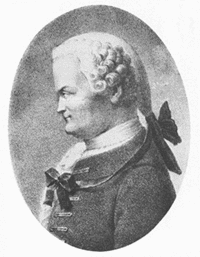A Short Account of the History of Mathematics
by W.W. Rouse Ball
Johann Heinrich Lambert
Additional Information
- Year Published: 1908
- Language: English
- Country of Origin: England
- Source: Ball, W.W.R. (1908). A Short Account of the History of Mathematics. London, New York: Macmillan.
-
Readability:
- Flesch–Kincaid Level: 12.0
- Word Count: 321
- Genre: History
- Keywords: biography
- ✎ Cite This
Downloads

Johann Heinrich Lambert was born at Mülhausen on August 28, 1728, and died at Berlin on September 25, 1777. He was the son of a small tailor, and had to rely on his own efforts for his education; from a clerk in some ironworks he got a place in a newspaper office, and subsequently, on the recommendation of the editor, he was appointed tutor in a private family, which secured him the use of a good library and sufficient leisure to use it. In 1759 he settled at Augsburg, and in 1763 removed to Berlin where he was given a small pension, and finally made editor of the Prussian astronomical almanack.
Lambert's most important works were one on optics, issued in 1759, which suggested to Arago the lines of investigation he subsequently pursued; a treatise on perspective, published in 1759 (to which in 1768 an appendix giving practical applications were added); and a treatise on comets, printed in 1761, containing the well-known expression for the area of a focal sector of a conic in terms of the chord and the bounding radii. Besides these he communicated numerous papers to the Berlin Academy. Of these the most important are his memoir in 1768 on transcendental magnitudes, in which he proved that is incommensurable (the proof is given in Legendre's Géométrie, and is there extended to ): his paper on trigonometry, read in 1768, in which he developed Demoivre's theorems on the trigonometry of complex variables, and introduced the hyperbolic sine and cosine denoted by the symbols sinh x, cosh x: his essay entitled analytical observations, published in 1771, which is the earliest attempt to form functional equations by expressing the given properties in the language of the differential calculus, and then integrating his researches on non-Euclidean geometry: lastly, his paper on vis viva, published in 1783, in which for the first time he expressed Newton's second law of motion in the notation of the differential calculus.